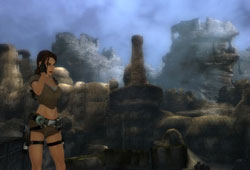Tomb Raider: Legend (PC)
Publisher: Eidos Interactive Developer: Crystal Dynamics
Genre: Third-Person Action Adventure Release Date: 04/11/2006
ESRB: Teen

Despite her legacy being sullied by some questionable installments of the series that brought her into being, Lara Croft is certainly a legendary gaming icon. As such, it's a good thing that the appropriately titled Tomb Raider: Legend turned out as it did. Things have changed a lot since the series was birthed in 1996, and what the original developers at Core seemed unable (or unwilling) to realize in the more recent Tomb Raider installments, Crystal Dynamics has delivered with aplomb. Tomb Raider: Legend represents Lara Croft's first solid foray into modern gaming, and has made the series relevant again.
Perhaps not surprisingly, the team at Crystal Dynamics has taken cues from a great many games when crafting Tomb Raider: Legend. When it comes to the mechanics and design of the platforming sequences, you'll notice that Prince of Persia: Sands of Time was a prevailing influence. Meanwhile, the game's puzzle elements resemble something you'd see in a Legend of Zelda or Metroid Prime game, and the interactive cutscenes are straight out of Shenmue or Resident Evil 4. Yes, despite the series' PC roots, Tomb Raider: Legend is a console game through and through. It looks and plays like one, and if you have a USB control pad, you're going to want to use it for the PC version.
This isn't to say that the game doesn't play well with the mouse and keyboard -- in fact, during most of my review, that's how I played it. That is because all of the action is fluid and forgiving enough to not require extremely precise inputs. The bulk of the game revolves around platforming and puzzle solving, and in these two areas it succeeds remarkably. Lara Croft is amazingly mobile and lithe, and traversing the game's intricately designed environments is immensely satisfying. She can vault from poles, shimmy across sheer ledges, swing Tarzan-style from ropes or vines, and when those aren't available, she's got a futuristic grappling hook that's sometimes awfully picky as to which surfaces it will stick to.
As mentioned before, the challenge doesn't come from the amount of precision you'll have to exercise when timing your jumps. Rather, it's all about figuring where you have to go and utilizing the terrain to get you there. Much like the modern Prince of Persia games, most of the environments are actually enormous geometric puzzles, which you'll have to survey for footholds and climbable surfaces before you make a stab at progressing through them. At worst, you'll have to gauge some jumps by means of trial and error. Death isn't a huge deal, as the checkpoints come with sufficient frequency, and of course, you can save at will.
In the traditional puzzles is where you'll find the game's meat. These tend to be epic in scale and convey a tangible sense of danger. They're also pretty creative, though usually on a superficial level -- at the end of the day, you're pushing blocks onto switches, despite how cool and intricate everything may look. Physics have been integrated into these elements for satisfying results; one of first puzzles you encounter has you catapulting boxes onto an elevated surface by means of a primitive see-saw. Yes, the end result involves you pushing said boxes onto tile triggers, but as they say, it's all about the journey.
Being a consummate action heroine, it goes without saying that Lara Croft knows how to fight. Indeed, rare is an extended puzzle sequences in Tomb Raider: Legend that isn't bookended by some sort of action sequence. Though they ostensibly serve as a means for you to blow off steam after a lengthy cerebral exercise, it's these elements that disappoint the most. In an attempt to keep things simple, the game autotargets for you, which, in theory, should do just that. The problem, however, is that once the reticle latches on to an unfortunate soul, it's very difficult to get it to switch. Rather than try, you typically just unload on your current target, despite how inopportune its location, and hope that the next target you'll latch onto is the one that's blasting you at point blank range. Apart from all this, Lara has a few other tricks up her sleeve. If she's in close proximity to a target, she can vault off their body before shooting them in the face. Think Prince of Persia, but with guns. Lara can also lob grenades without switching weapons, which comes in handy as well.
As a whole, Tomb Raider: Legend is quite enjoyable, and little sour points like the aforementioned don't do much to detract from the experience. Regrettably, though, the game is quite short -- expect to get through it in about seven to eight hours on your first run. There are some extras to keep you coming back, but nothing with any long-term staying power. Think new costumes, blooper reels, and the like. Also, incidentally, if you're thinking of clicking the "Next Gen Content" box in the video options menu, you'd better have a beefy system backing you up; I tried doing it, and the game was nigh unplayable, even though my system is pretty high-end. If you're after Xbox 360-caliber visuals, take note.
If you're looking for some polished and satisfying console-style action, you could certainly do worse than Tomb Raider: Legend. It's far from revolutionary, but as a m 閘 ange of elements that have proven successful in other action/adventure games, it's certainly entertaining and gratifying on many levels. It looks like Lara Croft is headed back into the limelight, and she has Crystal Dynamics to thank. We can't wait to see where she goes next.



